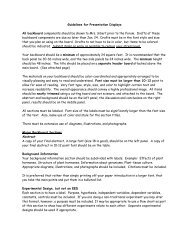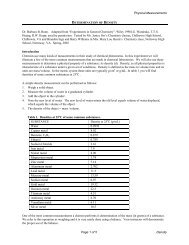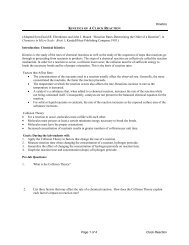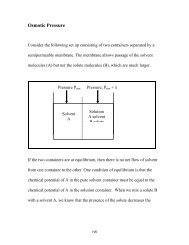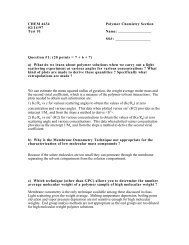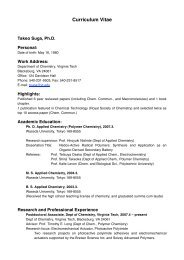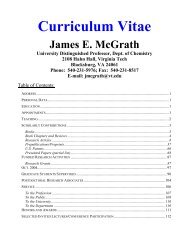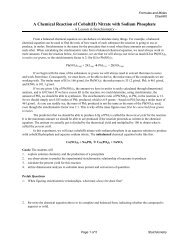Carlier Group Gaussian User Manual - Virginia Tech
Carlier Group Gaussian User Manual - Virginia Tech
Carlier Group Gaussian User Manual - Virginia Tech
Create successful ePaper yourself
Turn your PDF publications into a flip-book with our unique Google optimized e-Paper software.
<strong>Carlier</strong> <strong>Group</strong> <strong>Gaussian</strong> <strong>User</strong> <strong>Manual</strong> 35<br />
this manual for a detailed explanation of the sources of thermodynamic quantities,<br />
thermochemical output, and some worked-out examples.<br />
B. Setting up a calculation to obtain thermodynamic parameters<br />
Adding the ‘freq’ keyword to the route section prompts <strong>Gaussian</strong> to start calculating<br />
frequencies and thermodynamic parameters once the geometry is optimized. Note that<br />
the geometry of the structure must be optimized to obtain reliable thermodynamic data.<br />
Example:<br />
# rb3lyp/6-31g(d) opt freq<br />
It is important to note how these values are actually calculated. Free energy (G),<br />
enthalpy (H), entropy (S), and zero-point corrections are all derived from the vibrational<br />
frequencies of the optimized structure. These values are calculated as correction<br />
factors to be added to the original electronic energy. The example below shows how<br />
enthalpy (H) would be determined for an optimized structure:<br />
Example [thf: calculated at B3LYP/6-31G*]:<br />
A) Electronic energy=-233.449443 (hartrees)<br />
B) Thermal correction to enthalpy=0.123272 (hartrees)<br />
C) Therefore H = Electronic energy + enthalpic correction = -233.326171<br />
(hartrees)<br />
Multiplying this result by 627.51 will convert units to kcal/mol<br />
-233.326171 (hartrees) * 627.51 kcal/mol/hartree = -145786.9955<br />
kcal/mol<br />
This procedure must be applied to each molecular species in a thermodynamic cycle in<br />
order to obtain valid thermodynamic parameters.<br />
C. Locating thermodynamic data in the output file<br />
i. To get the thermal and free energy corrections to enthalpy<br />
pcarlier@inferno2:~/run> egrep correction h0498.out<br />
Zero-point correction= 0.147025<br />
(Hartree/Particle)<br />
Thermal correction to Energy= 0.152503<br />
Thermal correction to Enthalpy= 0.153447<br />
Thermal correction to Gibbs Free Energy= 0.119061<br />
Now you can take these corrections and apply them the electronic energy. This is<br />
especially convenient when you plan to apply the free energy correction at a lower basis<br />
(e.g. B3LYP/6-31G*) to a higher basis single point energy, or a PCM-corrected



